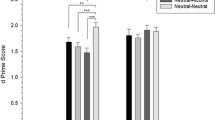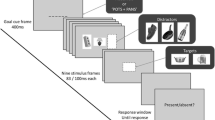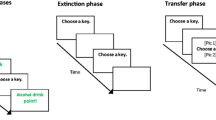Abstract
Rationale
In heavy drinkers, training attention towards alcohol cues increases alcohol craving, but it is not clear if effects of ‘attentional training’ generalise to novel stimuli and measurement procedures.
Objectives
We investigated possible generalisation of attentional training to novel alcohol cues and other methods of measuring cognitive bias.
Materials and methods
A modified visual probe task was used to train participants to direct their attention either towards (‘attend alcohol’ group) or away from (‘avoid alcohol’ group) alcohol cues; attentional bias was not manipulated in a control group (total N = 60). After attentional training, we measured cognitive bias (using visual probe, modified Stroop, flicker-induced change blindness and stimulus–response compatibility tasks), alcohol craving and alcohol consumption.
Results
Attentional bias for alcohol cues increased in the ‘attend alcohol’ group, and this effect generalised to novel stimuli, but not to other cognitive bias tasks. In the ‘avoid alcohol’ group, attentional bias was reduced for the stimuli that were used during attentional training, but these effects did not generalise to different stimuli or cognitive bias tasks. Alcohol craving increased among participants in the ‘attend alcohol’ group, but only among participants who were aware of the experimental contingencies during attentional training. There were no group differences in alcohol consumption.
Conclusions
The effects of attentional training show limited generalisation to different alcohol cues and methods of measuring cognitive bias. Experimentally increased attentional bias seems to increase subjective craving, but only among participants who are aware of the experimental contingencies that were in place during attentional training.




Similar content being viewed by others
References
Anton RF, Moak DH, Latham P (1995) The obsessive-compulsive drinking scale: a self-rated instrument for the quantification of thoughts about alcohol and drinking behaviour. Alcohol Clin Exp Res 19:92–99
Babor TF, Higgins-Biddle JC (2001) Brief intervention for hazardous and harmful drinking: a manual for use in primary care. World Health Organisation
Babor TF, Higgins-Biddle JC, Saunders JB, Monteiro MG (2001) The alcohol use disorders identification test: guidelines for use in primary care, 2nd edn. World Health Organisation
Bardo MT, Bevins RA (2000) Conditioned place preference: what does it add to our preclinical understanding of drug reward? Psychopharmacology 153:31–43
Conklin CA, Tiffany ST (2002) Applying extinction research and theory to cue exposure addiction treatments. Addiction 97:157–167
Cox WM, Yeates GN, Reagan CM (1999) Effects of alcohol cues on cognitive processing in heavy and light drinkers. Drug Alcohol Depend 55:85–89
Cox WM, Hogan LM, Kristian MR, Race JH (2002) Alcohol attentional bias as a predictor of alcohol abusers’ treatment outcome. Drug Alcohol Depend 68:237–243
Cox WM, Fadardi JS, Pothos EM (2006) The addiction-Stroop test: theoretical considerations and procedural recommendations. Psychol Bull 132:443–446
Duka T, Townshend JM (2004) The priming effect of alcohol pre-load on attentional bias to alcohol-related stimuli. Psychopharmacology 176:353–361
Edwards G (1996) Sensible drinking. Br Med J 312:1
Field M (2006) Attentional biases in drug abuse and addiction: cognitive mechanisms, causes, consequences, and implications. In: Munafo MR, Albery IP (eds) Cognition and addiction. Oxford University Press, Oxford, UK
Field M, Duka T (2001) Smoking expectancy mediates the conditioned responses to arbitrary smoking cues. Behav Pharmacol 12:183–194
Field M, Duka T (2002) Cues paired with a low dose of alcohol acquire conditioned incentive properties in social drinkers. Psychopharmacology 159:325–334
Field M, Eastwood B (2005) Experimental manipulation of attentional bias increases the motivation to drink alcohol. Psychopharmacology 183:350–357
Field M, Mogg K, Zetteler J, Bradley BP (2004) Attentional biases for alcohol cues in heavy and light social drinkers: the roles of initial orienting and maintained attention. Psychopharmacology 176:88–93
Field M, Mogg K, Bradley BP (2005) Craving and cognitive biases for alcohol cues in social drinkers. Alcohol Alcohol 40:504–510
Field M, Eastwood B, Bradley BP, Mogg K (2006a) Selective processing of cannabis cues in regular cannabis users. Drug Alcohol Depend 85:75–82
Field M, Mogg K, Bradley, BP (2006b) Attention to drug-related cues in drug abuse and addiction: component processes. In Wiers R, Stacy A (eds) Handbook of implicit cognition and addiction. Sage, Thousand Oaks, CA
Field M, Christiansen P, Cole J, Goudie A (2007) Delay discounting and the alcohol Stroop in hazardous drinking adolescents. Addiction 102:579–586
Franken IHA (2003) Drug craving and addiction: integrating psychological and neuropsychopharmacological approaches. Prog Neuropsychopharmacol Biol Psychiatry 27:563–579
Hogarth LC, Duka T (2006) Human nicotine conditioning requires explicit contingency knowledge: is addictive behaviour cognitively mediated? Psychopharmacology 184:553–566
Hogarth LC, Dickinson A, Duka (2005) Explicit knowledge of stimulus-outcome contingencies and stimulus control of selective attention and instrumental action in human smoking behaviour. Psychopharmacology 177:428–437
Jones BC, Jones BT, Blundell L, Bruce G (2002) Social users of alcohol and cannabis who detect substance-related changes in a change-blindness paradigm report higher levels of use than those reporting neutral changes. Psychopharmacology 165:93–96
Kavanagh DJ, Andrade J, May J (2005) Imaginary relish and exquisite torture: the elaborated intrusion theory of desire. Psychol Rev 112:446–467
LaBerge D (1995) Attentional processing. Harvard, Cambridge, MA
Love A, James D, Willner P (1998) A comparison of two alcohol craving questionnaires. Addiction 93:1091–1102
MacLeod C, Rutherford E, Campbell L, Ebsworthy G, Holker L (2002) Selective attention and emotional vulnerability: assessing the causal basis of their association through the experimental manipulation of attentional bias. J Abnorm Psychol 111:107–123
Marissen MAE, Franken IHA, Waters AJ, Blanken P, van den Brink W, Hendriks VM (2006) Attentional bias predicts heroin relapse following treatment. Addiction 101:1306–1312
Mogg K, Bradley BP (2002) Selective processing of smoking-related cues in smokers: manipulation of deprivation level and comparison of three measures of processing bias. J Psychopharmacol 16:385–392
Mogg K, Bradley BP, Field M, De Houwer J (2003) Eye movements to smoking-related pictures in smokers: relationship between attentional biases and implicit and explicit measures of stimulus valence. Addiction 98:825–836
Mogg K, Field M, Bradley BP (2005) Attentional and evaluative biases for smoking cues in smokers: an investigation of competing theoretical views of addiction. Psychopharmacology 180:333–341
Noel X, Colmant M, Van Der Linden M, Bechara A, Bullens Q, Hanak C, Verbanck P (2006) Time course of attention for alcohol cues in abstinent alcoholic patients: the role of initial orienting. Alcohol Clin Exp Res 30:1871–1877
Posner MI, Snyder CR, Davidson BJ (1980) Attention and the detection of signals. J Exp Psychol 109:160–174
Robinson TE, Berridge KC (1993) The neural basis of drug craving: an incentive-sensitization theory of addiction. Brain Res Brain Res Rev 18:247–291
Ryan F (2002) Detected, selected, and sometimes neglected: Cognitive processing of cues in addiction. Exp Clin Psychopharmacol 10:67–76
Schoenmakers T, Wiers RW, Jones BT, Bruce G, Jansen AM (2007) Attentional retraining decreases attentional bias in heavy drinkers without generalisation. Addiction 102:399–405
Stormark KM, Laberg JC, Nordby H, Hugdahl K (2000) Alcoholics’ selective attention to alcohol stimuli: automated processing? J Stud Alcohol 61:18–23
Sharma D, Albery IP, Cook C (2001) Selective attentional bias to alcohol related stimuli in problem drinkers and non-problem drinkers. Addiction 96:285–295
Thalheimer W, Cook S (2002) How to calculate effect sizes from published research articles: a simplified methodology. Retrieved February 15, 2007 from http://work-learning.com/effect_size_download.htm
Tiffany ST (1990) A cognitive model of drug urges and drug-use behaviour: role of automatic and nonautomatic processes. Psychol Rev 97:147–168
Tomie A (1996) Locating reward cue at response manipulandum (CAM) induces symptoms of drug abuse. Neurosci Biobehav Rev 20:505–535
Townshend JM, Duka T (2001) Attentional bias associated with alcohol cues: differences between heavy and occasional social drinkers. Psychopharmacology 157:64–67
Waters AJ, Shiffman S, Sayette MA, Paty JA, Gwaltney CJ, Balabanis MH (2003) Attentional bias predicts outcome in smoking cessation. Health Psychol 22:378–387
Wiers RW, de Jong PJ, Havermans R, Jelicic M (2004) How to change implicit drug use-related cognitions in prevention: a transdisciplinary integration of findings from experimental psychopathology, social cognition, memory, and experimental learning psychology. Subst Use Misuse 39:1625–1684
Wiers RW, Cox WM, Field M, Fadardi JS, Palfai TP, Schoenmakers T, Stacy AW (2006) The search for new ways to change implicit alcohol-related cognitions in heavy drinkers. Alcohol Clin Exp Res 30:320–331
Acknowledgements
This research was funded by a research grant from the Economic and Social Research Council (ESRC), reference RES-000-22-1860, awarded to Matt Field and Theodora Duka.
Author information
Authors and Affiliations
Corresponding author
Rights and permissions
About this article
Cite this article
Field, M., Duka, T., Eastwood, B. et al. Experimental manipulation of attentional biases in heavy drinkers: do the effects generalise?. Psychopharmacology 192, 593–608 (2007). https://doi.org/10.1007/s00213-007-0760-9
Received:
Accepted:
Published:
Issue Date:
DOI: https://doi.org/10.1007/s00213-007-0760-9




